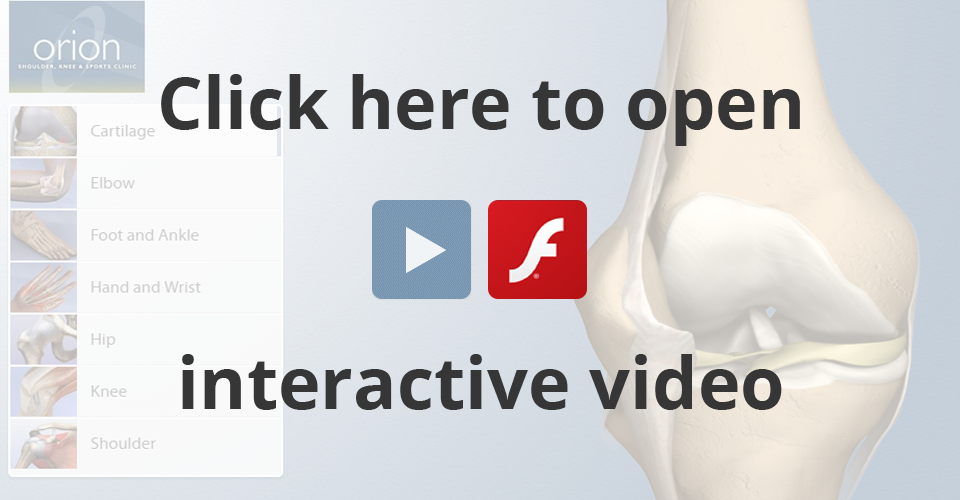Impingement and Rotator Cuff Problems
The rotator cuff is a group of 4 muscles that cover the ball and socket joint (the glenohumeral joint) and lie underneath an arch formed by the under-surface of the acromion and the coracoacromial ligament. This muscular tendinous unit normally glides smoothly without any friction. Impingement is said to occur when the tendons start rubbing against the under-surface of the acromion or thickened coraco-acromial ligament. This results in inflammatory changes within the tendon which is known as tendonitis. If left alone structural changes occur within the tendon, which is known as tendon degeneration or tendinopathy. When the tendons continue to rub over long periods of time then structural failure may occur in the tendon, which can result in a partial or even a full thickness rotator cuff tear. Patients with impingement or rotator cuff problems complain of pain with overhead activities. They localise the pain to the outer aspect of the upper arm and often have difficulty with simple tasks such as dressing and undressing themselves, acts of personal hygiene and even showering and bathing. They may also have difficultly lying on the affected side and may complain of weakness in the shoulder particularly on carrying out activities, which suggests a tear in the rotator cuff.
In the early stages of the disease symptoms can be treated through rest, activity modification and painkillers. If the symptoms do not settle within the next 4-6 weeks then a Specialist opinion is often required. A local anaesthetic and steroid injection may prove beneficial but it is important to note that a steroid injection in the presence of a tear can be detrimental and could actually result in increasing the size of the tear. Therefore accurate diagnosis and investigation in the form of an MRI are a must to rule out the presence of any rotator cuff tear.
If the symptoms do not settle with conservative measures and once a tear has been ruled out then a local anaesthetic and steroid injection may be given to the subacromial space to reduce the inflammatory process and thereby reduce the pain. This allows the physiotherapists to strengthen and retrain the rotator cuff group of muscles and improve shoulder function. There still exists a controversy as to the number of injections that should or could be given into the subacromial space. My belief is that not more than 2 injections should be given into the subacromial space and the time frame between the 2 injections should be at least 6 weeks. Furthermore at every stage it is imperative to rule out the presence of a rotator cuff tear.
If symptoms persist in spite of conservative measures including injections and physiotherapy then keyhole surgery may be required. This is done routinely as a day case procedure and the idea is to decompress the tendons by burring away the under surface of the acromion and thereby increasing the height of the ceiling of the subacromial space. Following an arthroscopic subacromial decompression the patient is placed in a sling for the next couple of weeks. Through regular physiotherapy and supervised shoulder rehabilitation good results can be achieved between the 6 week to 3 month points.
In the presence of a rotator cuff tear subacromial decompression surgery can be done through keyhole surgery, a mini open approach or through open surgery. The fine tuning of the surgical procedure is dictated by the size and the position of tear as well as the relative ease with which the tendon ends can be brought together. Following rotator cuff surgery patients are often in a sling for between 2-4 weeks. They are not permitted to drive for between 4-6 weeks although they may return to work and perform their desk duties within a couple of weeks from surgery. Through a regular physiotherapy and rehabilitation programme patients are encouraged to carry out overhead activities after 6-8 weeks and should be able to return to their normal level of work and sporting activities between 3 and 6 months from the time of surgery. Unfortunately, some patients may present to the clinic with a very late stage of the disease process in which case the rotator cuff cannot be repaired. In carefully selected individuals surgery may prove beneficial using augmentation techniques using synthetic grafts or muscle transfers.
Documentation
Pre-op Information PackShoulder Physio Protocols
- Arthroscopic Bankart Repair/Mini Open Bankart/Arthroscopic SLAP Repair: Rehabilitation Protocol
- Copeland Shoulder – Resurfacing Arthroplasty: Rehabilitation Protocol
- Arthroscopic Subacromial decompression and/or AC joint excision (partial/no cuff tear): Rehabilitation Protocol 1
- Arthroscopic Acromioplasty (Sub Acromial Decompression) with Rotator Cuff Repair (small/medium tears): Rehabilitation Protocol 2
- Open Acromioplasty ( Sub Acromial Decompression) with Rotator Cuff Repair (large tears): Rehabilitation Protocol 3
- Reverse shoulder replacement (delta3): Rehabilitation Protocol
- Manipulation under anaesthesia and/or Arthroscopic Capsular release of shoulder joint: Rehabilitation Protocol
Contact Us Directly
Sarah Morris, Secretary to Mr PimpalnerkarReferral forms to download:

